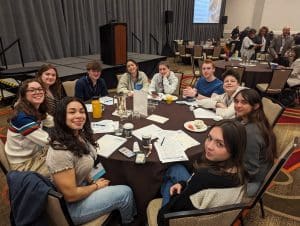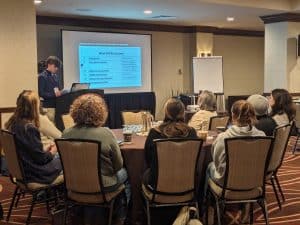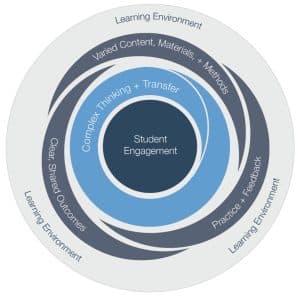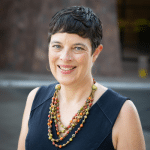Student Agency in Action
CompetencyWorks Blog
Our list of Ins and Outs for CBE in 2024 mixed what we’re seeing in the field with our biggest hopes and aspirations past, present, and future. Student agency was our first “CBE In.” We see more and more examples of listening deeply to students and authentically involving them in decision-making. Here are a few highlights of student agency I’ve come across in my travels in the first half of 2024.
Student Design Council in New Mexico
I had the opportunity to visit RFK Charter School in Albuquerque, NM in the days before Future Focused Education’s EdUprising conference. We ate lunch with around 20 Student Design Team members. Students volunteer to participate in this group, which started in 2022. The students on the council help shape the school’s efforts to innovate and engage every student on a pathway to thriving. Listening to their hopes and dreams, and what they’ve learned by being a part of the committee filled me with inspiration. As one student reflected, “I felt I was important and had a voice.”
Like many schools in New Mexico, RFK is working on a community-created Profile of a Graduate. In addition to the focus group with parents, teachers, and community members, involving students was a priority for school leaders. The Student Design Team led the student input on the graduate profile. They are helping to create a road map of competency benchmarks to set expectations through a student’s time at RFK. They also ran an art contest for the graphic of the profile which included presenting to the school’s Governing Council for approval and creating a campaign with the graphic. 
The Student Design Team also took the lead in organizing a school-wide college and career exhibition. They surveyed students to build on the ideas and interests of their peers about post graduation plans, and internships and mentorships during high school. The students led the outreach to businesses and colleges to participate in the day. One of their advisors reflected, “I’m really proud of their leadership and the skills they are building to be leaders within their own community. And it has just been a joyous thing to watch.”
We closed our time with a circle of the students sharing an experience at RFK that made a lasting impression or brought them joy in their learning. Here is just a sampling of their answers, which highlights the beauty of choice and a range of learning opportunities inside and outside of the classroom.
- Youth Conservation Corps, a program that gets students out to a school farm and grows food for a local food bank. One student shared, “I’m a gardener myself. I’ve always been used to getting dirty and shoveling. So like the fact that I can, like learn about something like that [the value of like food] at school. It’s really cool.”
- Classes from capstone to child development to a Spanish class to pursue the seal of biliteracy: “for me, personally, thanks to my class, I am able to present confidently in Spanish in front of a group of people, and I’m really proud of myself.”
- The Guns to Gardens program that repurposes guns into other objects like lamps, xylophones, and guitars.
- Doing a range of internships with Future Focused Education in areas from mental health to welding.
- A dual credit program called the Youth Arts Ambassadors where students made films about New Mexico and its culture.
Student Summits: A Vehicle for Student Voices in New England
At a March convening of the Barr Foundation Portrait of a Graduate cohort, one day of programming was modeled on the Springfield Public School’s Student Summit structure. This is a great example of the power of pursuing change as part of a community of practice, where school and district teams learn from each other and adapt effective strategies. Springfield has used the summit model to involve students’ voices in the district strategic planning process, including how to bring their Portrait of a Graduate to life in their learning communities. Springfield district leaders shared their story and underscored the importance of not only collecting input from students but truly incorporating the ideas from Student Summit conversations into the plan. 
Barr Foundation Portrait of a Graduate cohort participants used the model to listen to student experiences across their districts. Students from Springfield facilitated conversations with their peers from other places, while the adults listened, observed, and took notes about what they heard. Topics included navigating high school, grading and assessment, content and curriculum, classroom engagement, and life after high school.
I participated as a fishbowl observer for the content and curriculum group with these overarching questions driving the discussion: What are the skills and abilities that you think will serve you best in your future after HS? How often do you get to explore and practice those skills in your current classes? The student facilitators helped prepare discussion questions, which included:
- What is the most meaningful assignment you’ve worked on this year? Tell us about the assignment and what you accomplished.
- Can you give an example of a time when your learning connected to who you are as a person? How often should you have learning experiences like that?
- Do you think the things you are learning in school will help you after you graduate? Why or why not?
- How often are you able to make connections between what you are learning and apply it to the real world?
The current student experiences did not always reflect the ultimate vision. One student reflected, “I think a lot of what I’m learning feels redundant. I’m not really learning a lot. It doesn’t really feel meaningful, it feels like I’m checking a box to go off to college.” However, students also offered several bright spots to build on:
“[In one project], my teacher gave us some requirements of what had to be included in the circuit, but the rest of it was our judgment and our design to figure out how to get it to go through. It was a lot on us to decide what to do, and it helps you learn what to do and how to do it, and helps with the decision-making because you’re in a safe space where you can make a mistake, even if you don’t want to.”
“I did a health/walking class that allowed me to walk around town and learn about health and it helped me better than just going to class and writing because I could pause, walk and talk, and not only be in the classroom. It made me feel like I wasn’t just a chess piece in a room and I was actually being seen.
“My school is really big on being a prepared individual. In 11th & 12th grade we do portfolio presentations and student-led conferences instead of parent conferences, and we’re changing the whole system to be more of a presentation thing.”
My favorite quote from the “Blue Sky” dreaming portion of the discussion was: “We are the school, it is not the building. We could take it outside or go to different places to learn, we cannot limit ourselves to the building.”
The experience modeled a student-driven process that could help make these dreams and bright spots a reality. I hope that the participants could see themselves planning and contributing to future summits in their own districts and that the adults take to heart the message that when we ask students for their opinions and feedback, we must be prepared to do something about it. Students deserve to see the impact of their input on their community.
A Student-Adult Advisory Board Driving Change in a Massachusetts District

At the Great Schools Partnership (GSP) School Redesign in Action Conference, students presented in many of the sessions and were full participants as audience members. At the session entitled “How Student-Teacher Alliances Can Drive Educational Reform Forward,” a teacher and a student from Monument Mountain Regional High School co-presented, and I sat next to another student from MMRHS. In 2018, there was one student who was the first (and only) student member of a redesign committee and now MMRHS has a Student and Adult Advisory Board (SAAB), in which 60 students and six teachers work in six sub-teams. A steering committee guides “communication, collaboration, and leadership within the various committees.”
The MMRHS community wanted to build a shared vision for school redesign and cultivate collective efficacy to make change and evidence-informed decisions. They also wanted to put research into practice and focus on teaching and learning. They asked, “What do we mean by good teaching and learning?” and collected baseline data in student surveys administered by students. Teachers were also prompted to reflect on their practice, and the findings informed teacher professional development.
 Two key findings from the student data included that the students were 1) experiencing too much listening and talking about topics, but they preferred to learn more about the connections to using what they are learning in the real world, and 2) not receiving enough feedback on how to improve. To address the findings, the SAAB and teaching staff decided to use an action research cycle to focus on the ways teachers provide feedback to students, which is one of the elements of GSP’s elements of effective instruction. In subsequent learning cycles (the school’s goal is one per quarter) they’ve also worked on clear, shared outcomes and how to vary instructional strategies.
Two key findings from the student data included that the students were 1) experiencing too much listening and talking about topics, but they preferred to learn more about the connections to using what they are learning in the real world, and 2) not receiving enough feedback on how to improve. To address the findings, the SAAB and teaching staff decided to use an action research cycle to focus on the ways teachers provide feedback to students, which is one of the elements of GSP’s elements of effective instruction. In subsequent learning cycles (the school’s goal is one per quarter) they’ve also worked on clear, shared outcomes and how to vary instructional strategies.
MMRHS has also moved to de-level their courses and rethink grading as part of their school redesign process. A team (that included students) participated in the Next Generation Learning Challenges’ Vermont Learning Excursion, where they continued to reflect and envision their path forward together. They reported that as the school year wraps up, they are working with their Restorative Justice Team to do empathy interviews in advisories to find common roses and thorns across the student body and getting ready to shadow several students for a full day as part of a “student experience” study.
Listen to Students and Act on What You Learn
Even after my initial outlining of this post, more great moments of listening to students keep popping up. At the annual Edvestors School Showcase in Boston, a student panel shared their experiences and ideas for engaging students. Emilia Brito Fonseca described the empowerment they are feeling from starting a student voice group at Boston Adult Technical Academy, where students now bring ideas and feedback to their teachers. Lillianis Rodriguez Rivera, Student Council president at Fenway High School, spoke about the principal including the council on decisions about allocating parts of the school’s discretionary budget.
Whatever your work is within the education system, I challenge you to have a conversation with a young person. Where in your work can you apply feedback from students? I also welcome you to reach out to share your story of student agency in action!
Learn More
- Agency by Design: An Educator’s Playbook
- The Drive Towards Student Agency: Empowering Students to Make Choices on Their Learning Pathway
- Elevating Student Voice: Reflections From Across the U.S.
- UP for Learning Partners with Next Generation Learning Challenges (NGLC) During Vermont Learning Excursion
 Laurie Gagnon is the CompetencyWorks Program Director at the Aurora Institute. She leads the work of sharing promising practices shaping the future of K-12 personalized, competency-based education (CBE). Laurie lives in Somerville, MA with her partner, young son, and cat.
Laurie Gagnon is the CompetencyWorks Program Director at the Aurora Institute. She leads the work of sharing promising practices shaping the future of K-12 personalized, competency-based education (CBE). Laurie lives in Somerville, MA with her partner, young son, and cat.